Milling is a common manufacturing process where a rotating tool removes material from a stationary workpiece and delivers you parts with the desired finish. While the milling operation is basic, there are different types of milling machines, and the most important characterization is based on the orientation of the cutting tool.
Both horizontal milling and vertical milling machines have unique operational characteristics that make them suitable for specific operations and applications. The following text will take a look at the differences between vertical milling machines with horizontal milling machines and discuss their advantages and disadvantages.
A Brief Overview of Vertical Milling Machines
Vertical milling machines are the most common setup where you see the cutting tool in a vertical orientation. The tool presses against the stationary workpiece and removes the material according to your design requirements. In the industry, there are two types of vertical milling setups that are quite common.
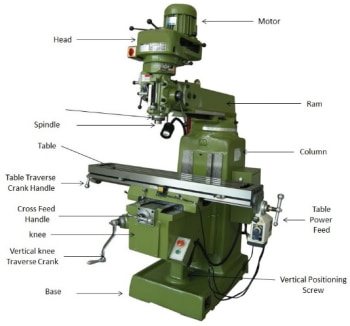
Turret Milling Machines
The turret milling setup is generally used for small parts. In this setup, the spindle containing the cutting tool remains stationary while the turret bed can move both horizontally and vertically.
Bed Milling Machines
Bed milling machines are more common, especially in a traditional machine shop. In this setup, the spindle can move vertically while the bed moves horizontally. Through the combination of these movements, you can create grooves, bores, and various other features easily.
A Brief Overview of Horizontal Milling Machines
Horizontal milling machines are slightly different. The basic operations remain the same. You’ll still have a stationary workpiece and a rotating tool. However, the orientation of the tool would have a horizontal orientation.
Generally, these milling machines are more common in cases where you are dealing with larger parts or deeper cuts. The overarm design and horizontal rotation of the tool results in more cutting power and faster operations, but at the result of precision. However, advances in CNC technology mean that horizontal milling machine centers don’t have that issue anymore.
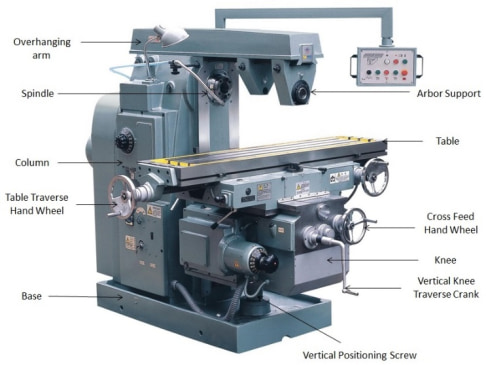
Another important thing to note about horizontal machines is their ability to deal with angles. If you use a universal table with a horizontal setup, you’d ensure that the cutter can approach the workpiece from a variety of angles and better handle more complicated designs.
Advantages and Disadvantages of CNC Vertical Milling Machines
CNC vertical machining centers have a series of advantages and disadvantages that make them suitable for a variety of jobs. Most of the advantages of the vertical setup stem from the machine’s lower cost and availability. Similarly, the limitations stem from the geometrical design and the cutting capabilities of the tool.
Here’s a brief breakdown of both pros and cons of a vertical milling setup.
The Pros
- Availability: Vertical milling setups are quite popular across the industry because of their lower maintenance requirements and costs. These machines are readily available in many fabrication shops and you can easily find experts who’ll be able to handle the requirements of a vertical machine.
- Lower costs: The vertical machine is readily available and has lower costs, which makes it easier for smaller businesses to invest in it and start the fabrication process.
- Simplicity in operations: Another advantage of vertical milling is operational simplicity. A vertical mill offers greater visibility to the users and even has lower programming requirements than its horizontal counterparts.
- Low-volume production: Because of their relative simplicity and lower costs, vertical mills are the method of choice for low quantities and quick jobs. Moreover, you won’t even have to spend too much time on programming and other planning activities, which further reduces your lead times.
The Cons
- Lower production output: We have already discussed how vertical mills have a lower material removal rate and can’t operate on large parts. Because of this, a vertical mill will always have a lower production output when compared with a horizontal machine.
- Limited cutting depth: Vertical cutting tool is quite unstable and may wobble a lot when you deal with a deeper cut. Because of that, you can’t deal with more complex parts and grooves with a higher depth. In such cases, the cutting capabilities that vertical machines bring to the table work as a disadvantage for many operations.
Advantages and Disadvantages of CNC Horizontal Milling Machines
Similar to the vertical setup, horizontal milling machines are the preferred choice for a variety of applications. Mostly their tool’s cutting power and other capabilities make them suitable for large-scale jobs with higher production requirements. Moreover, the limitations of the system are mostly because of the higher costs of purchasing and maintaining the machines.
Here’s a brief breakdown of both pros and cons of a horizontal milling setup.
The Pros
- Better chip evacuation: The metal chips that form during the cutting process can melt on the surface and cause small flaws that may require post-processing. Horizontal cutters throw the chips away from the piece, so can have a material with an exceptional finish.
- More stability: The cutting tool in horizontal machines is thicker and shorter, which results in lower vibrations and more stability during a deep cutting operation.
- Ability to handle complex shapes: Horizontal mills come with the ability to handle different angles and allow you to use a combination of add-ons to facilitate the production of complex shapes that a vertical milling setup can’t handle.
- Higher Productivity: Higher material removal rate, better chip evacuation, and the ability to get deeper cuts in one go allow you to achieve more in a shorter time and maintain excellent productivity.
The Cons
- Expensive: Compared to a vertical machine, horizontal milling setups are quite expensive in terms of both the initial capital and the maintenance costs. That’s why you’ll only find them in large-scale manufacturing setups. For small businesses, CNC machining services are a better alternative that doesn’t require any exuberant financial commitment from your business.
- Harder to find trained operators: Apart from the high initial and maintenance costs, you’ll also have a harder time finding trained operators with expertise in the horizontal milling machine. The reason is simple. As these machines are scarce, only a few people have actual hands-on experience with the machines.
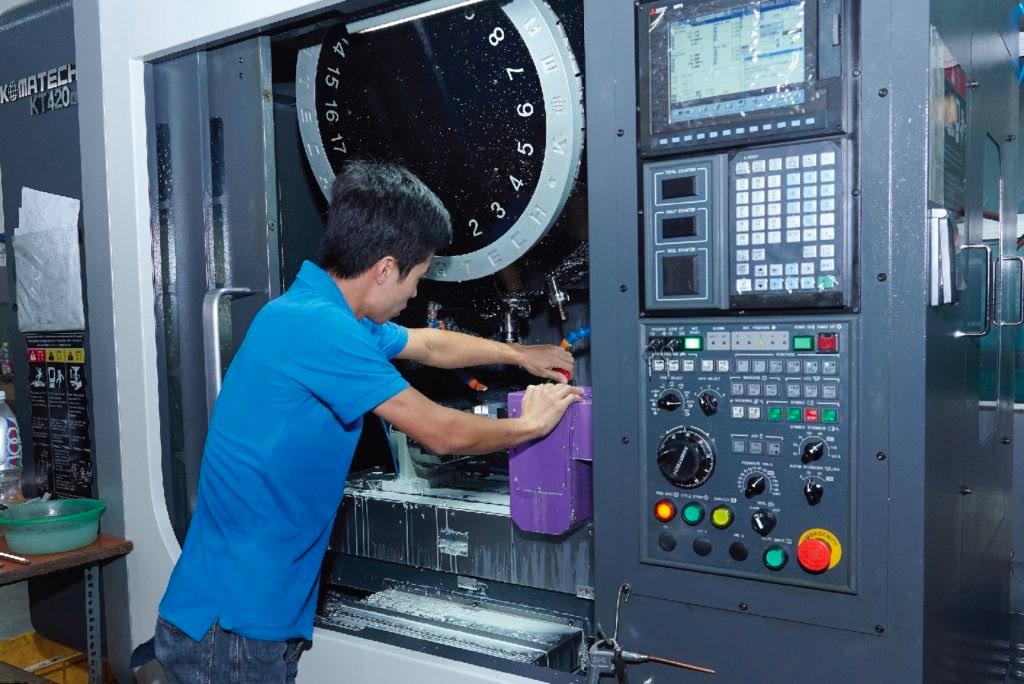
Horizontal vs Vertical Milling Machines: The Main Differences
As stated before, both horizontal and vertical approaches have a lot of similarities. The main reasons are the basic fundamentals of the milling process. They remain the same.
However, there are some significant differences that affect the operations and results as well. Here are the main differences between vertical and horizontal milling.
The Orientation of the Spindle
This is perhaps the biggest difference between the two setups. The orientation of the spindle dictates how the cutter interacts with the workpiece. As their names suggest both types of machines have different orientations that allow you to either have the precision that vertical machining offers or the depth that a horizontal setup brings to the table.
Tool Geometry
Another difference is in the geometry of the tool. Vertical milling machines have a cylindrical tool that is both long and thin. Contrarily, horizontal machines have shorter and thicker tools that can deliver deeper cuts and deal with larger workpieces. Generally, these geometrical specifications directly affect the cutting specifications, which we’ll discuss next.
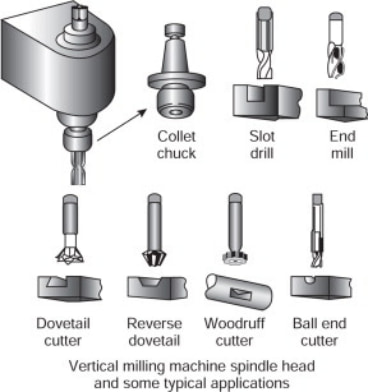
Cutting Specifications and Accuracy
The geometry of the tool has a direct effect on the cutting specifications and results. The vertical tool is more precise for smaller workpieces but has significant drawbacks as well. You can’t create deeper cuts with a vertical tool because it starts to vibrate and cause deviations from the design. Horizontal tools, on the other hand, are shorter and thicker, which gives them the stability to sustain the resistance while creating deeper cuts.
Cost of Each Machine
Vertical machines are less costly when compared to their horizontal counterparts. That’s why vertical machines are more common around the world. Moreover, the operations and maintenance of vertical machines are also simpler, which makes them a more suitable choice for small-scale operations.
Horizontal machines, on the other hand, are more expensive to purchase and maintain. Moreover, the experts who can handle these machines are scarce, which further increases the overall costs of CNC machining. However, these machines are important too. That’s why many manufacturing companies invest in them after they’ve established their business presence.
Material Removal Rate
When it comes to the removal rate, horizontal milling machines perform much better than their vertical counterparts because of their high stability and the ability to produce deeper cuts. Generally, vertical machines are popular for limited operations like facing and grooving because the cuts are not too deep in those cases and you can be precise as well. However, this limited cutting potential naturally means that the removal rate will be lower.
Number of Sides for Machining
We have already discussed how horizontal machines allow you to approach the workpiece at different angles and sides. Compared to that, vertical tools operate on a single plane.
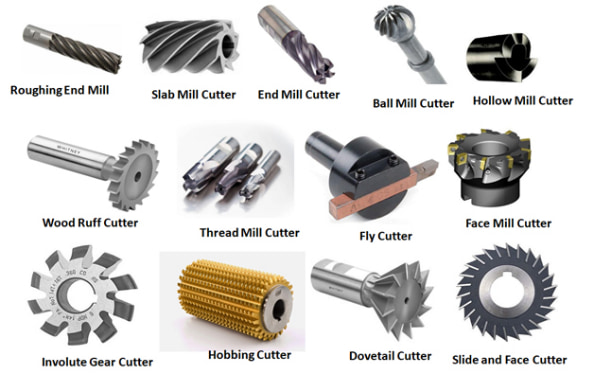
Furthermore, the horizontal setup is more suited for complex and customizable jobs as well. You can add certain add-ons and other features to the horizontal setup as well. These things are not available in a vertical mill, which limits the number of operations you can perform.
The Main Considerations for Choosing Between Vertical or Horizontal Machines
Both vertical and horizontal milling machines are suitable for a variety of tasks. But the right choice for you depends on several factors like the size, shape, the time required, and finally the overall budget you have.
For instance, a vertical setup is ideal for smaller workpieces. Vertical tools are cylindrical and small, which allows you to precisely target the areas you want. However, you can’t go too deep as vertical tools are designed for surface operations. Even when you create grooves using a vertical machine, it’s always recommended to take multiple turns while removing a small layer at every pass.
In the case of a horizontal machine, the aforementioned problem doesn’t exist. The cutting tool can handle larger workpieces, and the exceptional material removal rate can help you achieve the desired results in the shortest time.
Finally, the overall budget you have is another important factor that you should consider. If you are installing the entire setup in your own workshop, then it’s important to remember that horizontal milling machines are more expensive to buy and maintain. If you decide to approach a CNC machining service, then the overall installation and maintenance cost of these machines would become a moot point.
RapidDirect: Home of the Best CNC Machining Services
Purchasing CNC equipment can be extremely expensive, especially when it comes to horizontal milling machines. A CNC machining service can be the answer for you as it allows you to have access to the best services without committing to investing exuberant amounts towards purchasing the necessary equipment.
When it comes to the best CNC machining services in the market, RapidDirect is one of the most natural choices. RapidDirect also gives you access to the most experienced team with a versatile experience in the global market. Our experienced team strives to provide you with comprehensive service where our experts can help optimize the design as well.
That’s not all, our state-of-the-art online manufacturing portal comes with automatic features where all you need to do is to upload your CAD design file to get an instant quote.
Frequently Asked Questions
There are multiple types of milling machines besides horizontal and vertical milling machine, like column milling machines, C-Frame milling machines, bed type milling machines, etc. However, the most important characterization is according to the orientation of the tool which leaves you with either a vertical or a horizontal milling machine.
Column: The structural support for the entire machine that keeps the oil reservoir and the pump that lubricates the spindle.
Knee: The housing unit for the gearing mechanism inside the milling machine
Universal table: This table is used to keep the workpiece secured. It also allows you to approach through different angles as well.
Spindle: Holds and supports the cutting tool of the milling machine.
Overhanging arm: A horizontal beam on the top face of the column to create enough gap between the structure and the tool.
The main difference between the two types of machines is in the orientation of the tool. Vertical machines have a cylindrical tool that rotates on the perpendicular axis to the workpiece while the horizontal tool rotates around the axis around the surface of the part.
Generally, CNC milling machines have several limitations because of the size, axis movement, degree of freedom, and tool capabilities. Other than that, the overall cost of the CNC milling machine is another important limitation of CNC milling machines.


